HCMC – Vietnam’s industrial production, retail sales and newly established enterprises enjoyed positive growth in November thanks to improved economic conditions, according to the latest report of the World Bank.
The industrial production index increased by 5.5% month-on-month in November. This solid recovery partly reflected the resumption of economic activities in the southern localities, including HCMC (up 13.3% from October), the World Bank said in its Vietnam Macro Monitoring report.
With the ongoing recovery in November, the industrial production index exceeded the level observed a year ago. Food, tobacco, textiles and garments, rubber and plastic products, and metals were the most dynamic sub-sectors, posting double-digit year-on-year growth rates.
Retail sales increased by 6.2% month-on-month in November, driven by the continued recovery of domestic demand. However, retail sales remained 12.2% lower than in November 2020.
The sale of services, hit harder by social distancing measures than that of goods during the third-quarter lockdown, was recovering faster in the aftermath (12.5% compared to 5.2% month-on-month). Nevertheless, both were below the levels reported a year ago.
The number of newly established formal firms increased by 45% month-on-month in November, the second increase since May.
Firm exit numbers also increased, but at a slower pace than their entry. More businesses resumed than the number that suspended operations.
The overall improvement in the formal firm dynamics highlighted the fewer delays in the official registration of new businesses and business closures caused by the lockdown. The higher net entry could be attributed to improved economic conditions.
The trade surplus reached US$1.3 billion last month as the merchandise export growth accelerated from 6.1% year-on-year in October to 26.5% year-on-year in November, exceeding the import growth rate of 24.1%.
The strengthening export performance could be attributed to the resumption of manufacturing activities, particularly in high-tech product sectors.
The foreign direct investment (FDI) commitment increased by 71.2% month-on-month in November after a dip in October. This was mainly driven by recovering investment in manufacturing (up 40.2% month-on-month).
From January to November, the country attracted US$26.5 billion worth of FDI commitment, comparable to the amount committed in the same period of 2020. FDI disbursement continued to recover from the sharp decline in the third quarter (up 4.3% month-on-month in November) but has yet to reach the level observed a year ago.
After two months of decrease, the Consumer Price Index (CPI) increased by 0.3% month-on-month in November. This partly reflected the rising cost of transport (up 3.1% month-on-month) due to higher fuel prices, recovering domestic demand for non-food products, as well as increasing logistics costs.
Food prices continued to drop, falling by 0.2% month-on-month thanks to well-maintained food supply chains.
Compared to a year ago, CPI rose by 2.1% year-on-year, slightly higher than in October but well below the 4% target set by the State Bank of Vietnam.
In November, the budget surplus increased to VND120.3 trillion (US$5.2 billion), thanks to an additional surplus of VND45.4 trillion (US$2.0 billion). Total revenue was estimated to increase by 12.3% month-on-month and 33.4% year-on-year in November, partly reflecting the expiration of some business tax deferrals.
Total expenditure increased by 9.4% year-on-year in November for the first time since April 2021, thanks to the acceleration of public investment disbursement (up over 150% year-on-year).
The World Bank suggested that the Government continue supporting private demand to help the domestic economy recover and contribute to growth. “Providing support to impacted workers and households would be an essential avenue to achieve this objective,” the bank said.
Given the available fiscal space and difficulties registered in implementing the budget in 2021, the Government may also consider revenue measures to support domestic demand. This could include reducing the value-added taxes for 2022 to support private consumption.











